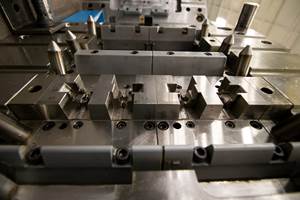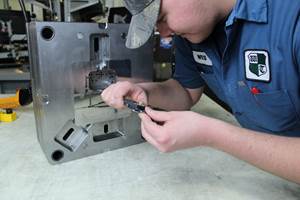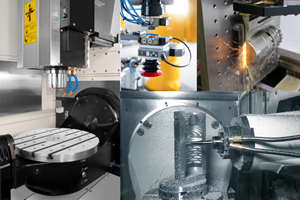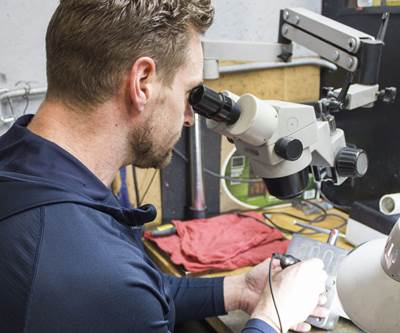Linear Motor Drive on Sinker EDM Machine Speeds Productivity
Linear motor technology in a sinker EDM machine enables Action Mold and Engineering to burn faster, more efficiently and more economically with minimal maintenance.
Action Mold and Machining: The name embodies the mission and the slogan of the veteran-owned, Grand Rapids, Michigan-based company, which states, “For quick-turn repair and engineering changes, we are your ‘Emergency Room for Molds.’” The company is known for fast service, so when it became clear that the current EDM machinery was not capable of keeping up with the speed of business in the mold industry anymore, Action Mold and Machining (Action Mold) invested in its first Sodick machine, an AG60L sinker EDM machine. That was five years ago, and Lead EDM Operator Bob Valk says, “With all of the past machines on which I have worked at Action Mold and previously, Sodick surpasses other brands in speed, setups, ease of maintenance and reliability.”
Linear Motor Speeds Productivity
Valk has more than 30 years of experience as an EDM operator and says that he has worked on several high-end EDM machines, but Sodick Inc. is the brand that stands out for high productivity without failure or the need for constant supervision. It is for this reason that Action Mold invested in a second Sodick product, an AG100L sinker EDM machine, two years later. “It has increased our burn times by 25 to 30 percent,” Valk says. “Setup time is substantially faster because the linear motor travels are so much faster.”
He explains that Sodick’s EDM machines use linear motors that run on magnetic plates instead of ball screws for travel, and that has allowed for faster travel speeds in the XYZ axis. “There are no gears that have to move together to move that table, which is the case with ball-screw action. The linear motors react faster and more smoothly,” Valk says, adding that EDM machines using ball screws also take longer to set up. “With the ball screws, the machinist has to jog that table to indicate a block to get it set up properly, which takes a lot longer than with the Sodick linear motor. The Sodick tables do not move, adding stability to the machine, and the machinist can put the indicator in the upper head, and the head moves back much more quickly.” He adds that a stationary table also enables the user to put a heavier block of steel onto it without hindering speed. If the table moves, as it does with ball-screw action, an excessively heavy workpiece could cause damage to the EDM machine.
According to Sodick Inc.’s Additive Business Development Manager Evan Syverson, no other brand offers linear motors on sinker-style EDM machines, though there is one company that offers it on its wire EDM machines. However, that company uses a very different linear technology. “The average competing EDM machine can travel about 50 inches per minute, whereas the Sodick feed rate is 94.5 inches per minute,” he says. “Additionally, in the Z-axis direction, a Sodick EDM machine has a 120-feet-per-minute jump speed compared to just a 20-feet-per-minute jump speed of other leading brands.”
Valk says that the six-times faster jump speed is significant because it makes the reaction time of the electrode substantially faster when it pulls out of the EDM cut as it is burning. “In other words, I can pulse the electrodes quicker, which allows me to flush them faster and achieve a better burning process as a result.”
Sodick Inc.’s Evan Syverson explains that other EDM machines have a completely different flushing process and that it comes back to the Z axis, which must jump as part of the flushing of the workpiece. “In general, to flush debris from the workpiece during machining, a manufacturer will either drill holes in the electrode through which they pump flushing fluid, or use an exterior spray nozzle to spray the workpiece with fluid. Option two only works in a small subset of applications, and option one usually will leave an unfinished area on the workpiece where the hole was because the electrode obviously cannot burn where the electrode has a hole,” he says. “In contrast, the Z axes on Sodick EDM machines can move so quickly that they create a vacuum force that blows the debris away from the work area. Thus, no flushing holes are needed.”
“[Sodick sinker EDM technology] has increased our burn times by 25 to 30 percent. Setup time is substantially faster because the linear-motor travels are so much faster.”
Bob Valk says, “My favorite aspect of a Sodick EDM machine is having the ability to burn small, deep ribs into steel without any problems.” He explains that accuracy in EDM depends on the flushing because not having the ability to flush the debris results in consequences. “On our old EDM machine, debris was not flushed well, and we would frequently get arcs that cause pits to form in the bottoms of the ribs, which could destroy the electrode. He says that with a Sodick machine, he could have an electrode measuring 0.020 inch that has to burn an inch deep, and because of the speed at which the machine moves and its acceleration, he can set it up, start the burn and walk away without worrying about arcing.
“On the AG60L, we have a 12-station tool changer that allows me to burn overnight, unattended, and it has never failed in operation,” he says. “Unattended burning has increased our profitability and has increased how much work we can produce during the day and at night.”
“Unattended burning has increased our profitability and has increased how much work we can produce during the day and at night.”
Economical EDM, Even on Hard-to-Machine Materials
When working with materials that are harder to machine, Valk says that his Sodick EDM machines power through and are very economical. “As EDM technology evolves and becomes faster, we’re not really limited by how difficult it is to machine the steel.” He says that Action Mold serves the aerospace, automotive and medical and dental industries, which often require Action Mold to work with unique materials like Ampco that are difficult to cut. The abrasiveness of Ampco wears out electrodes more quickly than other materials. He says, “Previously, we would have had to mill anything in this material on a CNC machine, but I have had great success burning it in less time and with less wear on the electrodes because of Sodick’s linear motor and control technology.”
According to Syverson, the hardness of the machined material does not influence the EDM process. Rather, it is the material’s electrical conductivity and abrasiveness that can pose challenges during the cutting process. Regarding conductivity, he says, “The shape or waveform of the electrical discharge will impact how efficiently material is removed, while the polarity of the discharge can also impact how fast cutting is performed and how much wear the electrodes will experience. Sodick has generators and a cutting-condition database in its controls that help operators easily achieve the optimal settings for very fast burning.”
Valk’s ability to burn abrasive materials faster than a CNC could mill them is because of the Sodick machine’s jump speed in the Z axis, Syverson says. “Milling abrasive materials like Ampco wears down end mills more quickly in a machining center, thus limiting the speed at which a CNC machine can mill. Sodick EDM machines, on the other hand, still can be quite fast because the jump speed in the Z axis enables the user to burn more frequently.”
Valk adds that he has also noticed that he uses fewer electrodes on the Sodick EDM machines. “When I’m burning Ampco with a Sodick EDM machine, I only need three electrodes to finish one location as opposed to needing four with other machines,” he says. “That’s a 25 percent reduction in machining time to cut carbon, which can be substantial, plus the savings that I gain in the cost of the graphite and cutting tools. I have also found that I can run EDM using a less expensive graphite and still get the same quality and tolerance as I would get with a higher-grade graphite, which makes it even more economical. Because we can do more with less material expense and in less time, Sodick machines have enabled our company to quote jobs more competitively.”
Because we can do more with less material expense and in less time, Sodick machines have enabled our company to quote jobs more competitively.
He says that previously, for example, Action Mold might quote 1,000 hours for a new mold. With the time and material savings just in EDM using Sodick machines, the Action Mold team might be able to reduce that job quote to 950 hours. This can also be a significant cost saving for customers needing repair work or engineering changes, he says, because often molds come into the shop without valuable CAD data, so CNC milling is not an option. The company’s coordinate measuring machine is used to reverse-engineer the mold details to create electrodes.
When he is asked how the Sodick EDM technology compares with hard milling, Valk says, “I know that hard milling is a big trend now, but increasingly there are steels and alloys of harder and harder grades in development, and having the ability to hard mill these materials requires more and more expensive equipment. We try to avoid that situation to keep our pricing competitive and also because EDM technology is getting faster with linear motors and can usually do the work faster—at times as much as 50 percent faster.”
Powerful Controls
Valk says that when he is performing a job, Sodick Inc.’s EDM controller enables him to select any finish, regardless of tolerance. “The control is smart and very user-friendly, even for an entry-level machinist, and the controller gives the operator multiple choices of finish, tolerance, electrode size and orbit, making the work flexible in speed.” For example, he says that whether the size of the electrode the machinist is using is like a pencil or like a coffee can, the control will tell the machinist how much voltage and amperage is necessary to establish what the machinist wants to finish. It also recommends how undersized the electrode needs to be to get the final product machined with EDM, which is a great benefit since, with some other EDM machines he has used, putting more power through the electrodes to accelerate the process often creates pits in the steel that are too deep to clean during the finishing process.
According to Valk, Sodick Inc.’s Motion Controller Technology, which controls movements of the axes and monitors spark-gap changes, ensures an instantaneous response to the user’s data transmission. This helps accelerate the EDM process while ensuring accuracy, quality and very little maintenance. “Sodick has a 10-year positioning-accuracy guarantee on its machines,” he says. “That is very valuable because, if the machine ever goes out of tolerance, Sodick will fix it.”
Related Content
Mold Builder Meets Increased Domestic Demand With Automated Cells
Burteck LLC experienced significant demand increases due to reshoring and invested in automated machining cells to step up its production output quickly and avoid losing business.
Read MoreExtensive Evaluations Build The Plastek Group’s EDM Arsenal
Sinker and wire EDMs selected for speed, volumetric accuracy, surface finish, reliability, cost of ownership and extensive warranty.
Read MoreMachine Monitoring Platform Improves Machine Utilization, On-Time Delivery
Using data from a machine monitoring platform, Westminster Tool added almost 75 hours of capacity per week by shortening warmups and starting CNC and EDM machines sooner.
Read MoreDiscover Metalworking Technologies Targeted to Mold Shops
What EDM, automation and machining technologies are currently available to the mold manufacturing industry? MMT has compiled a list of some of the latest.
Read MoreRead Next
Determination and Skill Save Critical Micro-Mold Cavity
Team 1 Plastics Inc. found a new supplier “soul mate” in Alliance Specialties and Laser Sales (Wauconda, Illinois), which displayed a commitment to, and the skills for, a successful micro-mold cavity repair solution.
Read MoreAre You a Moldmaker Considering 3D Printing? Consider the 3D Printing Workshop at NPE2024
Presentations will cover 3D printing for mold tooling, material innovation, product development, bridge production and full-scale, high-volume additive manufacturing.
Read MoreHow to Use Strategic Planning Tools, Data to Manage the Human Side of Business
Q&A with Marion Wells, MMT EAB member and founder of Human Asset Management.
Read More

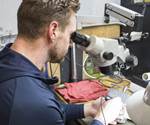








.jpg;maxWidth=300;quality=90)


_300x250 3.png;maxWidth=300;quality=90)









